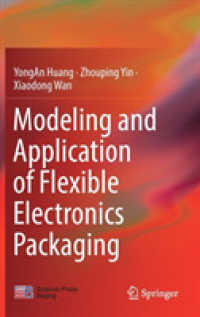- ホーム
- > 洋書
- > 英文書
- > Computer / General
Full Description
Writing and running software is now as much a part of science as telescopes and test tubes, but most researchers are never taught how to do either well. As a result, it takes them longer to accomplish simple tasks than it should, and it is harder for them to share their work with others than it needs to be.
This book introduces the concepts, tools, and skills that researchers need to get more done in less time and with less pain. Based on the practical experiences of its authors, who collectively have spent several decades teaching software skills to scientists, it covers everything graduate-level researchers need to automate their workflows, collaborate with colleagues, ensure that their results are trustworthy, and publish what they have built so that others can build on it. The book assumes only a basic knowledge of Python as a starting point, and shows readers how it, the Unix shell, Git, Make, and related tools can give them more time to focus on the research they actually want to do.
Research Software Engineering with Python can be used as the main text in a one-semester course or for self-guided study. A running example shows how to organize a small research project step by step; over a hundred exercises give readers a chance to practice these skills themselves, while a glossary defining over two hundred terms will help readers find their way through the terminology. All of the material can be re-used under a Creative Commons license, and all royalties from sales of the book will be donated to The Carpentries, an organization that teaches foundational coding and data science skills to researchers worldwide.
Contents
Welcome
0.1The Big Picture
0.2 Intended Audience
0.3 What You Will Learn
0.4 Using this Book
0.5 Contributing and Re-Use
0.6 Acknowledgments
Getting Started
1.1 Project Structure
1.2 Downloading the Data
1.3 Installing the Software
1.4 Summary
1.5 Exercises
1.6 Key Points
The Basics of the Unix Shell
2.1 Exploring Files and Directories
2.2 Moving Around
2.3 Creating New Files and Directories
2.4 Moving Files and Directories
2.5 Copying Files and Directories
2.6 Deleting Files and Directories
2.7 Wildcards
2.8 Reading the Manual
2.9 Summary
2.10 Exercises
2.11 Key Points
Building Tools with the Unix Shell
3.1 Combining Commands
3.2 How Pipes Work
3.3 Repeating Commands on Many Files
3.4 Variable Names
3.5 Redoing Things
3.6 Creating New Filenames Automatically
3.7 Summary
3.8 Exercises
3.9 Key Points
Going Further with the Unix Shell
4.1 Creating New Commands
4.2 Making Scripts More Versatile
4.3 Turning Interactive Work into a Script
4.4 Finding Things in Files
4.5 Finding Files
4.6 Configuring the Shell
4.7 Summary
4.8 Exercises .
4.9 Key Points
Building Command-Line Tools with Python
5.1 Programs and Modules
5.2 Handling Command-Line Options
5.3 Documentation
5.4 Counting Words
5.5 Pipelining
5.6 Positional and Optional Arguments
5.7 Collating Results
5.8 Writing Our Own Modules
5.9 Plotting
5.10 Summary
5.11 Exercises
5.12 Key Points
Using Git at the Command Line
6.1 Setting Up
6.2 Creating a New Repository
6.3 Adding Existing Work
6.4 Describing Commits
6.5 Saving and Tracking Changes
6.6 Synchronizing with Other Repositories
6.7 Exploring History
6.8 Restoring Old Versions of Files
6.9 Ignoring Files
6.10 Summary
6.11 Exercises
6.12 Key Points
Going Further with Git
7.1 What's a Branch?
7.2 Creating a Branch
7.3 What Curve Should We Fit?
7.4 Verifying Zipf's Law
7.5 Merging
7.6 Handling Conflicts
7.7 A Branch-Based Workflow
7.8 Using Other People's Work
7.9 Pull Requests
7.10 Handling Conflicts in Pull Requests
7.11 Summary
7.12 Exercises
7.13 Key Points
Working in Teams
8.1 What is a Project?
8.2 Include Everyone
8.3 Establish a Code of Conduct
8.4 Include a License
8.5 Planning
8.6 Bug Reports
8.7 Labeling Issues
8.8 Prioritizing
8.9 Meetings
8.10 Making Decisions
8.11 Make All This Obvious to Newcomers
8.12 Handling Conflict
8.13 Summary
8.14 Exercises
8.15 Key Points
Automating Analyses with Make
9.1 Updating a Single File
9.2 Managing Multiple Files
9.3 Updating Files When Programs Change
9.4 Reducing Repetition in a Makefile
9.5 Automatic Variables
9.6 Generic Rules
9.7 Defining Sets of Files
9.8 Documenting a Makefile
9.9 Automating Entire Analyses
9.10 Summary
9.11 Exercises
9.12 Key Points
Configuring Programs
10.1 Configuration File Formats
10.2 Matplotlib Configuration
10.3 The Global Configuration File
10.4 The User Configuration File
10.5 Adding Command-Line Options
10.6 A Job Control File
10.7 Summary
10.8 Exercises
10.9 Key Points
Testing Software
11.1 Assertions
11.2 Unit Testing
11.3 Testing Frameworks
11.4 Testing Floating-Point Values
11.5 Integration Testing
11.6 Regression Testing
11.7 Test Coverage
11.8 Continuous Integration
11.9 When to Write Tests
11.10 Summary
11.11 Exercises
11.12 Key Points
Handling Errors
12.1 Exceptions
12.2 Writing Useful Error Messages
12.3 Testing Error Handling
12.4 Reporting Errors
12.5 Summary
12.6 Exercises
12.7 Key Points
Tracking Provenance
13.1 Data Provenance
13.2 Code Provenance
13.3 Summary
13.4 Exercises
13.5 Key Points
Creating Packages with Python
14.1 Creating a Python Package
14.2 Virtual Environments
14.3 Installing a Development Package
14.4 What Installation Does
14.5 Distributing Packages
14.6 Documenting Packages
14.7 Software Journals
14.8 Summary
14.9 Exercises
14.10 Key Points
Finale
15.1 Why We Wrote This Book
Appendix
A Solutions
B Learning Objectives
C Key Points
D Project Tree
E Working Remotely
F Writing Readable Code
G Documenting Programs
H YAML
I Anaconda
J Glossary
K References
Index







